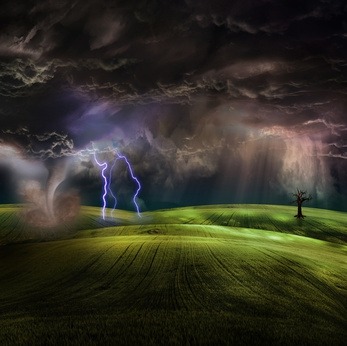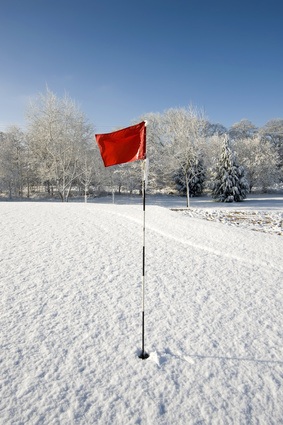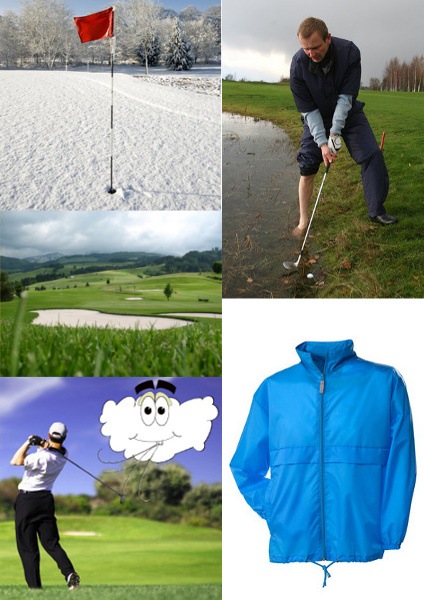
Most would agree that a bad day on the golf course is better than a good day at work. That becomes debatable when the weather turns ugly, which can make the course as miserable as a windowless cubicle.
Since the game is played outdoors over four-plus hours, an occasional spot of rain is inevitable. Sometimes, it s not coming down quite hard enough to chase you back to the clubhouse, and you re forced to deal with it.
PGA pros are used to this scenario; it takes a pretty good downpour (or lightning) for Tour officials to interrupt a round. Some golfers, like Tom Watson, thrive under inclement conditions, but most do not. They tough it out, though, by being prepared and following a few simple steps.
Of course, it helps to have the right attitude.
Why It s Important
If you live in the tropics or the Pacific Northwest, playing in the rain is a fact of life. In reality, no place is entirely immune to a bout of the wet stuff.
Rainy-day golf can be a trying experience. There s discomfort, inconvenience and a slower pace, plus unpredictable playing conditions. No one (except maybe Watson) enjoys slogging through a round in rotten weather – which gives an edge to the golfer who s ready for it both physically and mentally.
What You Should Watch
The pros rely heavily on their caddies when a shower arrives. You probably don t have that luxury, but you can still learn from their actions.
You ll notice that the pros are obsessive about keeping their hands and grips dry. A towel is always handy and constantly in use, and they ll go through several gloves during a rain-soaked round. Moisture between hands and grip can lead to disastrous club slippage, and must be vigilantly avoided.

The pros clubfaces are also dried before each shot. Water in the grooves causes “fliers,” or shots that travel farther than expected and bounce when landing, due to a lack of spin. The ball is also wiped down when it s allowed to be picked up (e.g. on the green, between holes, and in the fairway if “lift, clean and place” rules are in effect).
Nothing can be done about wet grass, so pros mitigate the flier effect by playing less club (8-iron instead of 7) if they fear a shot might come off hot. On the other hand, steady rain pelting a flying ball will cause it to lose distance, another factor to consider. Plus, mud on the ball can severely alter its trajectory and direction.
Given all these variables and uncertainties, most pros will adopt a more conservative approach, aiming away from hazards they might normally challenge.
When the rain has been especially heavy or sustained over several days, puddles pop up on the course. This is called “casual water,” and the rules allow you a free drop, no nearer the hole, at the closest point of relief. If water is visible under the ball or your feet before or after you take a stance, you re entitled to a drop. (See USGA Rule 25 for complete details.) The pros never hit a shot from casual water, especially when it affects the ball s lie.
One more thing: All pros carry a lightweight, waterproof rain suit they can easily slip into and out of when necessary.
Apply It to Your Game
First, check the forecast before heading to the course. If there s a chance for rain, pack a few towels, at least two gloves and waterproof gear. If the skies open up and you re determined to press on, remember these tips:
- Make sure your hands and grips are dry before each swing.
- Between shots, remove your glove and put it in a plastic bag.
- Wipe down the clubface, cleaning off moisture and mud, before every shot.
- Dry your golf ball whenever possible.
- If riding a cart, cover your bag so no water gets in.
- Familiarize yourself with the casual water rule and invoke it as necessary.
- If conditions get really muddy, lift, clean and place your ball in the fairway (but not the rough or hazards).

How to Deal with Inclement Weather
In your mind, you probably picture all of your rounds of golf being played under warm, sunny skies. Your drives will soar well down the fairway thanks to the mild temperatures, and the greens will be firm and fast. This is a beautiful mental picture for every golfer, and it represents what many would consider a perfect day on the links.
Of course, it usually has nothing to do with reality. Sure, you will have plenty of great days like this on the course. Depending on where you live, they may even be the norm rather than the exception. However, for all serious golfers, playing in inclement weather from time to time is just part of the experience. Golf is an outdoor game, and as such, you are going to deal with some tough conditions on occasion. It could be rain, wind, cold, or any combination of the three. Whatever the case, an accomplished golfer needs to know how to perform well even when the weather is putting up a fight.
In this article, we are going to offer a variety of pieces of advice for playing your best in inclement weather. It should be noted that this article is about more than being able to post a low score in tough conditions – it is also about having fun in the process. There is no point in being out on the golf course if you aren t going to have fun. By learning how to deal with rough weather as effectively as possible, you can not only get through the day with a decent score, but you can truly enjoy yourself as well.
It is particularly important to learn how to deal with difficult weather if you plan on playing in any local or regional competitions as part of your golf experience. When you are just playing a casual round with friends, you can always cancel if the weather doesn t look appealing. That isn t the case with a tournament. Unless the course is unplayable, or the weather is dangerous, the competition will go on. That means you are going to have to find a way to play your best – or close to your best – even when the weather is less than ideal for golf. This is a challenge, to be sure, but plenty of golfers have taught themselves over the years how to play well in inclement weather, and you can do the same.
All of the content below is based on a right-handed golfer. If you play left-handed, please take a moment to reverse the directions as necessary.

Equip Yourself Properly
The first step to playing well in tough weather conditions is to have the right gear in your bag – and on your body. You don t necessarily need to spend large sums of money in order to play good golf in bad weather, but you do need to have a few essential pieces available. The exact gear that you choose to purchase and carry is going to depend on the typical weather patterns where you live. Think about the conditions you are most likely to encounter on a regular basis and shop accordingly.
Some basic items that all golfers should consider owning in order to deal with inclement weather are as follows –
- Rain gear. This is an easy place to start. Basic rain gear includes a jacket, pants, and possibly a hat. You should buy golf-specific rain gear rather than trying to repurpose articles from another walk of life. Why? Easy – golf rain gear is specifically designed to allow the freedom you need to swing the club while on the course. If you use another kind of rain jacket, you might feel restricted – or you may even tear the jacket – while making your swing. There are certainly some rather expensive pieces available for you to purchase, but you can find some moderately priced items which will do the job just fine.
- A few towels. If the inclement weather in question is going to include rain, it is a good idea to pack your bag with a couple of extra towels (beyond the one you probably carry anyway). Keep these towels in a dry compartment inside your bag so you can pull them out during the middle of the round when you need a dry surface. These can be used for drying yourself off, drying off your grips, or just about any other purpose where a fresh towel will be handy. There are plenty of golf-specific towels on the market, but just about any kind of towel will do. Of course, these should be towels you don t mind getting dirty, because they probably won t finish the round nearly as clean as when they started.
- Lightweight layers. The best way to deal with cold weather on the course is to dress in layers. These should be lightweight layers, as to maintain your flexibility during the swing. Instead of wearing a heavy jacket, you can just build up a few layers which will make it easy to swing and still stay warm. Another benefit to dressing in layers is the fact that you can take them off or add them throughout the day as necessary. The temperature on the course is likely to fluctuate over the course of four hours, and using a layer system is your best bet to stay comfortable from the first tee to the last green.
- Gloves. No, you aren t going to hit your shots while wearing gloves. However, you can keep the gloves on while you walk up the fairway, or ride in the cart, to keep your hands warm. This is about more than just being comfortable. By keeping your hands warm, you should have better feel in your hands, and you should be able to play better golf. When it is time to hit your shot, simply slide the gloves off and play as usual. Then, slip them back on and move on to the next shot. Once you get into the routine of using gloves on a cold day, it will start to feel like a natural part of going through the round.
- Hand warmers. Staying on the topic of keeping your hands warm enough to feel the club properly, disposable hand warmers are a great item to keep your bag if you live in a cold region. These small packets activate when you open the package, and they usually offer several hours of warmth. When they are done, you just throw them away and use a fresh one for your next round. Hand warmers are available for a low cost, and they are frequently carried in pro shops during the winter months.
- An umbrella. Okay – so this one probably should have landed at the top of our list. Either way, it is important to have an umbrella in your bag at all times – unless there is no chance of rain. Actually, you may want to keep your umbrella in your bag even if there is no rain in sight, as you can use it for a sun shade on particularly hot days. Most golf bags have a dedicated spot for an umbrella, so pick one up and consider it an essential part of your golf equipment. While any umbrella could technically work, it would be best to buy a golf-specific umbrella which features a large canopy and the ability to hold together in windy conditions.
The list above might seem like a long one, but you actually won t need to spend that much money to compile a nice collection of bad weather golf gear. As you continue to gain experience in this game, and you deal with more and more tough conditions as the years go by, you will probably develop your own preferences for which pieces of gear offer the most aid on nasty days.

Making a Plan
Now that we have the equipment side of the discussion out of the way, it is time to talk tactics. In other words, how are you going to approach a round of golf which will be played in difficult conditions? It would be a mistake to use the same game plan that you use when playing on a perfectly clear, calm day. The game plan you use while on the course has a lot to do with the score you are able to write down at the end of the day.
In order to adjust your game plan properly to deal with inclement weather, consider the tips listed below.
- Play with more margin on all shots. This is standard operating procedure for an experienced golfer when the weather turns ugly. No matter what kind of bad weather you are dealing with – cold temperatures, wind, rain, etc. – the first adjustment you should make is to give yourself more margin for error on all of your shots. That means aiming for the middle of the fairway rather than trying to play down one side for a better angle. It also means playing toward the middle of the green rather than aiming right at the pin. You can t expect to be as accurate with your shots in bad weather as you would be on a nice day, so plan accordingly and give yourself more room to use. This type of golf takes some patience, but patience is something you ll need to have plenty of if you re going to play well in bad weather.
- Keep the ball down. Here we find another point which is almost universally used by experienced players who know how to handle tough conditions. By keeping the ball down lower to the ground, you will give the conditions less of a chance to negatively impact your shots. For instance, rather than hitting your driver way up into the air on a windy day, consider using a three wood to send a lower shot down the fairway. In this case, you will be trading distance for control – which is a trade you should always be willing to make in inclement weather. This same concept applies on approach shots, where you will likely benefit by bringing the ball in lower to the ground. Learn how to hit a solid punch shot and then use that shot consistently when the weather turns against you.
- Make controlled swings. It is easy to lose your balance on a windy day, and your feet can slip out from under you from time to time when playing in the rain. So, no matter what kind of tough weather you are facing, it is likely a good idea to make controlled swings which prioritize balance over everything else. Making hard, aggressive swings in bad weather is trouble for a couple of reasons. First, you might lose your balance and badly miss-hit the shot. Also, a hard swing is likely to generate a lot of backspin and a high ball flight, so you might find trouble even if you do make good contact. Either way, the best thing you can do is keep yourself under control and focus on executing your fundamentals. You might be surprised to find just how well you can play when making a simple, controlled golf swing.
There is nothing complicated about the right game plan to use on a tough weather day. In fact, keeping it simple is the whole point. You are going to aim for safe targets, do your best to keep the ball down close to the ground (when possible), and make controlled golf swings. Following these steps will not make playing in inclement weather an easy task, but it will make it easier than it would have been if you made no adjustments at all





